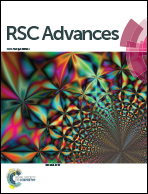PEGylated CsxWO3 nanorods as an efficient and stable 915 nm-laser-driven photothermal agent against cancer cells
Abstract
WO3−x nanomaterials have been demonstrated to be one kind of efficient near-infrared (NIR) laser-driven photothermal nanoagents, but their photothermal stability is still unsatisfied. In addition, a 980 nm laser is usually used as NIR light source, but it has an overheating effect due to optical absorption of water and biological specimens. To address these problems, we have prepared PEGylated Cs-doped WO3 (CsxWO3) nanorods by a solvothermal synthesis—PEGylation two-step route. CsxWO3 nanorods have diameters of ∼11 nm and lengths of ∼50 nm, and they exhibit increased absorption in the NIR region (700–1100 nm). With PEGylated CsxWO3 nanorods as the photothermal nanoagent, we compare the overheating and penetration effects of 915 and 980 nm lasers as NIR light sources. Compared with the 980 nm laser, the 915 nm laser provides drastically less overheating of water, and higher penetration ability of water/skin due to quite low water absorption. Importantly, under the irradiation of a 915 nm laser, CsxWO3 nanorods exhibit excellent photothermal conversion performance with high stability. Furthermore, by the photothermal effect of PEGylated CsxWO3 nanorods, in vivo cancer cells can be efficiently destroyed under the irradiation of a 915 nm laser. Therefore, PEGylated CsxWO3 nanorods can be used as a promising efficient and stable NIR-laser-driven photothermal agent against in vivo cancer cells.


 Please wait while we load your content...
Please wait while we load your content...